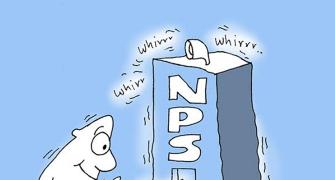The aggressive life cycle fund will allow equity exposure of up to 75%, up from the current limit of 50%.
 The Pension Fund Regulatory and Development Authority (PFRDA) is planning to launch two more life cycle funds for National Pension System (NPS) subscribers in the private sector.
The Pension Fund Regulatory and Development Authority (PFRDA) is planning to launch two more life cycle funds for National Pension System (NPS) subscribers in the private sector.
An expert committee constituted in September 2014 and headed by G N Bajpai handed over its recommendations to PFRDA, which has in turn come out with a discussion paper inviting stakeholders’ comments.
The proposal to allow investment into alternative asset classes elicited mixed views.
“PFRDA needs to specify what the alternative asset classes will be. A five per cent allocation is not a bad idea from the point of view of diversification,” says Ankur Kapur of Gurgaon-based ankurkapur.in.
Financial planner Arnav Pandya, however, is not enthusiastic about this proposal. “Having exposure to alternative asset classes is not a good idea in the Indian context as people don’t understand the risks that come with this exposure,” he says.
The first fund planned is an Aggressive Life Cycle Fund. This will have up to 75 per cent exposure to equities at the age of 35.
The equity exposure will keep on reducing progressively and will decline to 15 per cent by the age of 55.
The second one under consideration is a Conservative Life Cycle Fund.
Here, the maximum exposure to equities will be 25 per cent at the age of 35 and it will fall to five per cent by age 55.
At present, NPS offers a default life cycle fund wherein the equity exposure is 50 per cent at age 35 and comes down to 10 per cent by age 55.
The committee has made a couple of suggestions. One is to make the existing default fund more dynamic, allowing for review of asset class E, C, G allocation based on market conditions.
A third life cycle fund, wherein exposure of up to five per cent is allowed to alternative assets, may also be considered.
Experts are of the view that by catering to people with different risk appetites, these two new funds will make the NPS more attractive.
“Different people have different requirements. These proposed funds will be able to cater to the needs of both aggressive and conservative investors,” says Pandya. Earlier, the grouse that many investors with high risk appetite had against the NPS was that if they were investing for 30 years or more, they should be allowed a higher allocation (than 50 per cent) to equities for their returns to be optimal.
Manoj Nagpal, chief executive officer of Outlook Asia suggests that if the equity exposure limit is being raised to 75 per cent in life cycle funds, it should also be raised to the same level in the active choice option.
As for the proposal to make the existing default fund more dynamic, experts suggest that a lot of deliberation should be done on this count, since sticking to a pre-decided asset allocation is what investors want above all from a life-cycle fund.
The proposal to allow investment into alternative asset classes elicited mixed views.
“PFRDA needs to specify what the alternative asset classes will be. A 5 per cent allocation is not a bad idea from the point of view of diversification,” says Ankur Kapur of Gurgaon-based ankurkapur.in. Pandya, however, is not enthusiastic about this proposal.
“Having exposure to alternative asset classes is not a good idea in the Indian context as people don't understand the risks that come with this exposure,” he says.
Experts suggest that whatever choices the PFRDA offers should be backed by rigorous data modelling.
For instance, the conservative option offers a 25 per cent allocation to equities at age 35, which goes down to five per cent by the age of 55.
PFRDA needs to check whether over a 20-year horizon, investors will get a return that is considerably better than from a pure debt fund for the higher risk they assume (of 25 per cent exposure to equities).
Illustration: Uttam Ghosh










